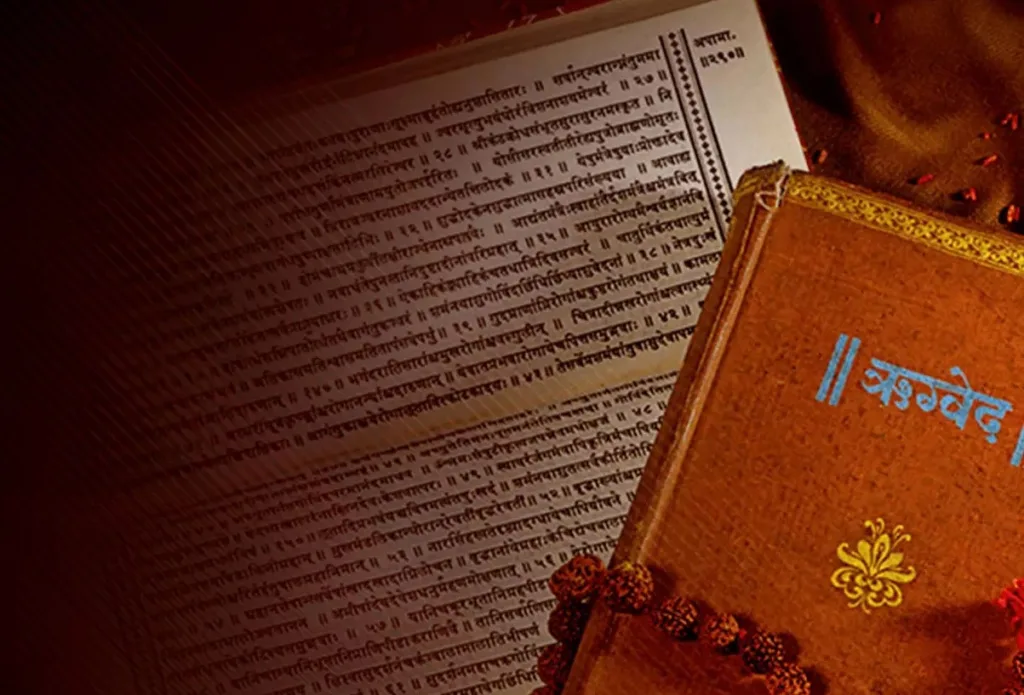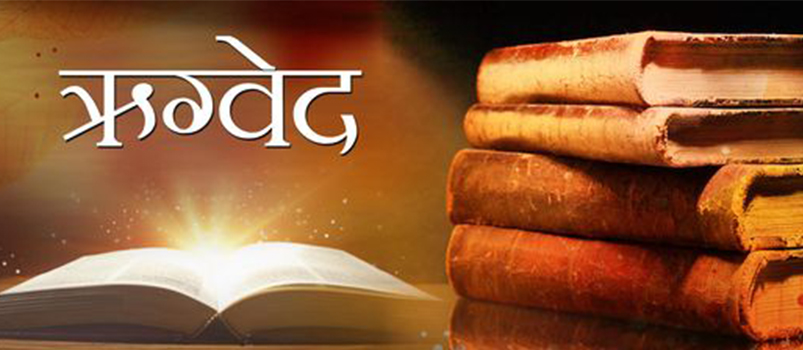Have you ever wondered about the hidden depths of the Rigveda, the oldest and most revered of the Hindu scriptures? This ancient text, composed over 3,500 years ago, holds the key to understanding the foundations of Hindu philosophy, rituals, and beliefs. But what lies beneath the surface of these ancient hymns?
The Rigveda, made up of 1,028 hymns, is divided into ten sections known as mandalas. These hymns explore ideas about creation, the natural world, and the divine.
Each one acts as a prayer to different gods, like Agni, the fire deity, and Indra, the leader of the gods, while also discussing the social norms and ethical dilemmas of that period.
Exploring Rigveda: The Invisible World of Ancient Wisdom Through This Blog.
By exploring its verses, we not only discover the essence of ancient Indian spirituality but also timeless questions about existence, morality, and our place in the universe. Join me as we explore into this invisible world, revealing how these ancient words still echo in our lives today.
Introduction to the Rigveda
The Rigveda is one of the most ancient sacred texts in the world, believed to have been composed around 1500 BCE. As one of the four Vedas, it plays a vital role in Hindu philosophy and spirituality.
Written in ancient Vedic Sanskrit, the Rigveda contains more than 1,000 hymns, referred to as sūktas, which are grouped into ten sections known as mandalas. Each hymn is dedicated to various gods and natural phenomena, reflecting the beliefs and practices of early Indian culture.
![Rigveda: Exploring the Invisible World of Ancient Wisdom Amazing Facts about Rigveda [1 min read]](https://fairgaze.com/images/UploadedImages/thumbs/0073261_0073261_bnr.jpg) The Rigveda not only emphasizes worship but also engages with profound philosophical questions about existence, ethics, and the universe. Its verses are rich in metaphor and poetic expression, encouraging readers to explore deeper meanings.
The Rigveda not only emphasizes worship but also engages with profound philosophical questions about existence, ethics, and the universe. Its verses are rich in metaphor and poetic expression, encouraging readers to explore deeper meanings.
By exploring the Rigveda, we can gain valuable insights into the spiritual and cultural foundations that shaped ancient Indian society and continue to impact modern Hindu beliefs.
Historical Context of the Rigveda
The historical setting of the Rigveda is important for appreciating its relevance. It was created during a time when Indo-Aryan tribes were migrating into the Indian subcontinent, bringing along their distinct cultural and spiritual traditions.
The Rigveda reflects this significant transition, showcasing the early Vedic society, which was mainly focused on pastoral and agricultural lifestyles. The hymns provide deep insights into the social organization, rituals, and values of that time.
 For example, they highlight the central role of fire worship and the rituals dedicated to deities like Agni, the fire god, and Indra, the king of the gods. The text provides valuable insights into the geographical features of ancient India, mentioning rivers and natural phenomena that were crucial to everyday life.
For example, they highlight the central role of fire worship and the rituals dedicated to deities like Agni, the fire god, and Indra, the king of the gods. The text provides valuable insights into the geographical features of ancient India, mentioning rivers and natural phenomena that were crucial to everyday life.
In addition, the Rigveda reveals the political dynamics of early Vedic tribes, highlighting important events like the Battle of the Ten Kings, which shows the struggles and alliances among different clans.
This ancient scripture reflects a society in transition, as oral traditions began to be formalized in writing, a key moment for cultural preservation.
Furthermore, the Rigveda’s focus on nature and deities highlights the strong connection between the early Vedic people and their environment, showcasing how their spiritual beliefs were intertwined with the natural rhythms around them.
Read – https://itihaaskikhoj.in/4-vedas-the-pillars-of-indian-knowledge/
Structure and Composition of the Rigveda
The Rigveda is carefully organized into ten mandalas, each featuring a range of hymns that differ in length and topics. This arrangement showcases a rich variety of themes and historical contexts within the text.
The first four mandalas are viewed as the oldest, primarily centering on hymns honoring different deities, while the later mandalas bring in more philosophical discussions and social commentary.
Every hymn has its own unique role—some call for blessings, while others tackle ethical issues or explore cosmic mysteries. The Rigveda’s language is both poetic and filled with symbolism, offering a wealth of material for linguistic and literary study.
Moreover, these hymns were originally shared through oral tradition before being written down, highlighting a remarkable practice that kept this ancient knowledge alive through the ages.
In addition, the hymns of the Rigveda are organized not just by their themes but also by their specific ritual purposes, enabling priests to choose the right hymns for various ceremonies. This practical feature of the text shows the close connection between religious rituals and daily life in ancient Vedic culture.
Furthermore, the mandalas are organized thematically rather than chronologically, showcasing the development of ideas surrounding divinity, nature, and human life during the Vedic period.
Read about Hinduism – https://itihaaskikhoj.in/exploring-hinduism-the-worlds-oldest-religion/
Themes Explored in the Rigveda
The Rigveda covers a broad spectrum of themes that mirror the spiritual beliefs and practical issues of ancient society. At the heart of its teachings are ideas like creation, sacrifice, and the concept of cosmic order (Rta).
The hymns often ask essential questions about existence, such as “Who is responsible for creating the universe?” and “What sustains life?” These questions reveal a deep philosophical curiosity about the mysteries of life.
The Rigveda is full of intriguing tales about the origins of the universe and where we fit into it. A great example is the Nasadiya Sukta, which tackles the big question of creation and whether anyone really knows how it all started.
The Veda also stresses the role of yajna, or sacrifice, in keeping the cosmic balance and building connections between humans and gods. This practice highlights the belief that our actions can impact divine favor and bring prosperity to our communities.
Additionally, many hymns emphasize moral and ethical themes, highlighting virtues such as truth, compassion, and justice. The Rigveda also addresses social concerns relevant to its time, including governance and the welfare of the community.
Check about the river ganga – https://itihaaskikhoj.in/the-ganges-a-divine-journey-through-hindu-history/
Rituals and Practices in the Rigveda
Rituals are super important in the Rigveda, showing just how crucial they were in early Vedic culture. The hymns lay out clear steps for different ceremonies meant to please the gods or ask for blessings like health and wealth.

Fire rituals, known as yajnas, are especially highlighted; they involve making offerings to Agni, who serves as a link between humans and the divine. These rituals were more than just formalities; they were believed to uphold cosmic order and foster social harmony.
Additionally, some hymns act as protective spells against illness or bad luck, indicating an early mix of health practices with spiritual beliefs. By examining these rituals in the Rigveda, we can better understand how ancient Indians aimed to connect with divine powers while addressing their everyday needs.
Philosophical Insights from the Rigveda
The Rigveda isn’t just a bunch of hymns; it’s a deep philosophical work that tackles big questions about life and awareness. It pushes us to think about ourselves and the universe, diving into ideas like self-realization (Atman) and universal consciousness (Brahman).
 The well-known Nasadiya Sukta even questions the origins of existence, which feels super relevant to today’s philosophical debates. Plus, it talks about dharma (duty), highlighting the importance of living ethically in tune with the universe.
The well-known Nasadiya Sukta even questions the origins of existence, which feels super relevant to today’s philosophical debates. Plus, it talks about dharma (duty), highlighting the importance of living ethically in tune with the universe.
These philosophical ideas laid the foundation for later Indian thought, especially in the Upanishads, which build on Vedic principles. By looking at these teachings today, we can uncover their relevance in understanding life’s deeper meanings.
Read another blog – https://itihaaskikhoj.in/mantra-power-mantras-for-spiritual-growth-and-clarity/
Conclusion
Exploring the Rigveda reveals a complex mix of ancient insights that are still relevant today. The hymns provide a glimpse into spiritual ideas, ethical standards, rituals, and philosophical thoughts that have shaped Indian culture for ages. As one of the oldest texts in existence, it connects us to our ancestors’ views on life and morality, while also guiding us in our current lives. The Rigveda’s lasting influence encourages us to ponder our place in the cosmos and motivates us to seek wisdom through self-exploration and a connection to the natural world. We hope you liked the blog. Do check out our website for more!

